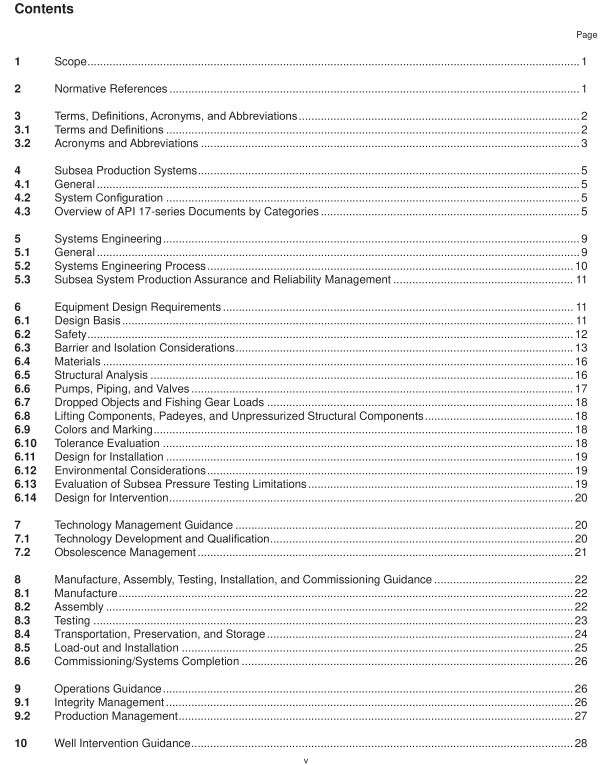API RP 17A pdf download

API RP 17A pdf download Design and Operation of Subsea Production Systems―General Requirements and Recommendations
APl 17N,Recommended Practice for Subsea Production System Reliability and Technical RiskManagement.Reliability is critical to subsea production system design and operation.This recommendedpractice (RP) provides a comprehensive approach to help ensure that reliability needs are achieved withsubsea systems. It is broadly referenced in the deepwater technical community as a foundation document foraddressing reliability.
API170,Recommended Practice for High Integrity Pressure Protection Systems(HIPPS).This standardestablishes criteria for high integrity pressure protection systems(HIPPS) that are seeing increased utilizationin industry as a means to safely provide overall system pressure capability while restricting the section thatrequires full shut-in pressure rating to a segment that is close to the source.
API 17Q, Recommended Practice for Subsea Equipment Qualification.This RP provides guidance onrelevant qualification methods that may be applied to facilitate subsea project execution.
APl17V,Recommended Practice for Analysis,Design, Installation, and Testing of Safety Systems forSubsea Applications. This RP provides a comprehensive treatment of the requirements for safety systemsnecessary for a variety of subsea applications.
-API17TR5,Avoidance of Blockages in Subsea Production Control and Chemical Injection Systems.ln addition to addressing the avoidance of blockages,this report also includes requirements and givesrecommendations for the design and operation of subsea production systems with the aim of preventingblockages in control and production chemical fluid conduits and associated connectors/fittings.
APl 17TR6, Attributes of Production Chemicals in Subsea Production Systems. Production chemicalsdelivered to a subsea production system via a chemical injection system can be complex formulations thathave a wide range of chemical and physical properties. In service, the production chemicals can come intocontact with other fluids,metallic and polymeric materials,and a range of physical conditions related totemperature and pressure.This report was developed with the objective of minimizing the risk of a productionchemical not being delivered at the required volumetric rate due to inadequate specification of the productionchemical delivery system or formation of restrictions or blockages in that system.
APl17TR13,General Overview of Subsea Production Systems.This document provides descriptions andbasic design guidance on subsea production systems.
4.3.2 Subsea Hardware (Wellheads,Trees,Manifolds,Structures,Connectors, and Pumps)Subsea documents that address assembled equipment include:
一API17D,Specification forSubsea Wellhead and TreeEquipment.This specification provides specifications
for subsea wellheads,mudline wellheads, dill-through mudline wellheads,vertical and horizontal subseatrees,and the associated tooling for handling, testing, and installing this equipment.
APl17P, Recommended Practice for Structures and Manifolds of Subsea Production Systems.This RPaddresses recommendations for subsea structures and manifolds used for pressure control in both subseaproduction of oil and gas and subsea injection services.
一API 17X,Recommended Practice for Subsea Pump Module Systems. This RP provides guidance forthe design,manufacture,installation, and operation of subsea pumps,including rotary displacement androtodynamic types for single-phase and multiphase services. This RP applies to all subsea pump modulesplaced at or above the mudline.
API17TR3, An Evaluation of the Risks and Benefits of Penetrations in Subsea Wellheads Below theBOP Stack. This report documents the results of a study of the risks and benefits of additional penetrationsin subsea wellheads below the blowout preventer (BOP) stack for the purpose of monitoring additional casing annuli for sustained casing pressure.Special attention was paid to the risk and benefits introduced bymonitoring annuli other than the” A” annulus (the annulus between the production tubing and the productioncasing strings).
-AP117TR4, Subsea Equipment Pressure Ratings. The impact of operation in deep water on the pressurerating of equipment is a special concern. The objective of this document is to foster a better understandingof the effects of simultaneous internal and external pressures on the rated working pressure of equipmentcovered by the scope of API 17D.
API17TR7,Verification and Validation of Subsea Connectors. This document provides requirementsand recommendations for the verification and validation of subsea connectors along the vertical centerlineof subsea hardware (i.e., tree, tubing head, tree cap, tree running tool, well control package connectors, andEDP connectors), the subsea wellhead, and the completion/workover riser.The methodology provided hereinmay also be used in other connector designs.Connectors outboard of the vertical centerline are addressedin APl 17R.
— API17TR8,High-Pressure High-Temperature (HPHT) Design Guidelines.Current APl standards for deep
water typically cover applications where the shut-in pressure is 15,000 psi or less. In recent years, industry hasbeen pursuing deepwater assets that have shut-in pressures above 15,000 psi, and operators and regulatoryagencies have had to address these applications on a singular basis.APl 17TR8 establishes a standardizedindustry approach to the analysis, design, material selection, testing, and application of subsea componenthardware for these HPHT applications.
API17TR11, Pressure Effects on Subsea Hardware During Flowline Testing in Deep Water. This reportprovides guidance to the industry on allowable pressure loading of subsea hardware components that canoccur during hydrotesting of subsea flowlines and risers and during pre-commissioning leak testing of thesesystems. There are potential problems with confusion arising from high hydrostatic pressure in deep water,partially due to the variety of applicable test specifications and partly from the inconsistent use of a variety ofacronyms for pressure terminology.
— API17TR12,Consideration of External Pressure in the Design and Pressure Rating of Subsea
Equipment. Historically, consideration of the benefit of external pressure in deepwater applications has beenaccepted in some applications involving the design and pressure rating of pipe.This report provides a detailedreview of the full system considerations that must be taken into account if one is to consider external pressurein the design of an irregular-shaped subsea pressure-containing or pressure-controlling device.









